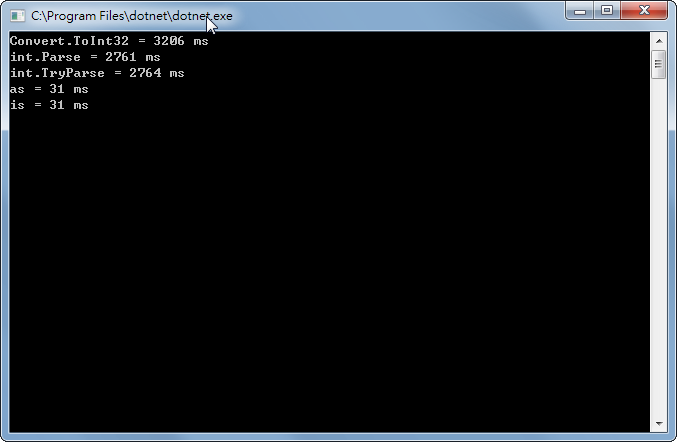最近再磨練基本功的時候複習了常用到的「轉型」,找一找資料後統整了一下才比較搞懂這些差異。
轉型別基本上分為下列五種:
- Convert(轉型)
Convert.ToInt32("5.5"); - Parse(強制轉型)
(int)(5.5); int.Parse("5.5"); - TryParse(安全轉型)
int i = 0; int.TryParse("5.5", out i) - 運算子 – as
CustomModel model = obj as CustomModel
- 運算子 – is
CustomModel model = obj is CustomModel
根據參考資料差異如下:
- Convert 是將值轉換成最接近的 32 位元帶正負號的整數
Console.WriteLine(Convert.ToInt32("4.5")); //result = 4 Console.WriteLine(Convert.ToInt32("4.51"));//result = 5 Console.WriteLine(Convert.ToInt32("5.4")); //result = 5 Console.WriteLine(Convert.ToInt32("5.5")); //result = 6 - Parse 則是無條件捨去( long、float、double、或 decimal )
Console.WriteLine((int)(4.5)); //result = 4 Console.WriteLine((int)(4.51));//result = 4 Console.WriteLine((int)(5.4)); //result = 5 Console.WriteLine((int)(5.5)); //result = 5
- TryParse 會回傳一布林值來判斷是否轉換成功
string s1 = "1234"; string s2 = "1234.65"; string s3 = null; string s4 = "123456789123456789123456789123456789123456789"; bool success = false; int result = 0; success = Int32.TryParse(s1, out result); //-- success => true; result => 1234 success = Int32.TryParse(s2, out result); //-- success => false; result => 0 success = Int32.TryParse(s3, out result); //-- success => false; result => 0 success = Int32.TryParse(s4, out result); //-- success => false; result => 0
- as 若轉型失敗會回傳null,且只能用於參考類型,不能應用於值類型(除非是Nullable的值類型)。
CustomModel model = obj as CustomModel; if(model != null) { //轉型成功 } else { //轉型失敗 } - is 若轉型失敗則會跳Exception
try { CustomModelt = obj is CustomModel; } catch { //轉型失敗 }
2017/09/24 更新
(Net Core 2.0)效能上 Parse > TryParse > Convert。

測試程式碼:
class Program
{
static void Main(string[] args)
{
Stopwatch sw = new Stopwatch();
sw.Start();
for (int i = 0; i < 10000000; i++)
{
Convert.ToInt32(i.ToString());
}
sw.Stop();
Console.WriteLine(string.Format("Convert.ToInt32 = {0} ms", sw.ElapsedMilliseconds));
sw.Reset();
sw.Start();
for (int i = 0; i < 10000000; i++)
{
int.Parse(i.ToString());
}
sw.Stop();
Console.WriteLine(string.Format("int.Parse = {0} ms", sw.ElapsedMilliseconds));
sw.Reset();
sw.Start();
for (int i = 0; i < 10000000; i++)
{
int.TryParse(i.ToString(), out int tmp);
}
sw.Stop();
Console.WriteLine(string.Format("int.TryParse = {0} ms", sw.ElapsedMilliseconds));
sw.Reset();
object model = new TestModel
{
Tmp = 100
};
sw.Start();
for (int i = 0; i < 10000000; i++)
{
var tmp = model as TestModel;
}
sw.Stop();
Console.WriteLine(string.Format("as = {0} ms", sw.ElapsedMilliseconds));
sw.Reset();
sw.Start();
for (int i = 0; i < 10000000; i++)
{
var tmp = model is TestModel;
}
sw.Stop();
Console.WriteLine(string.Format("is = {0} ms", sw.ElapsedMilliseconds));
sw.Reset();
Console.ReadKey();
}
public class TestModel
{
public int Tmp { get; set; }
}
}
參考:
